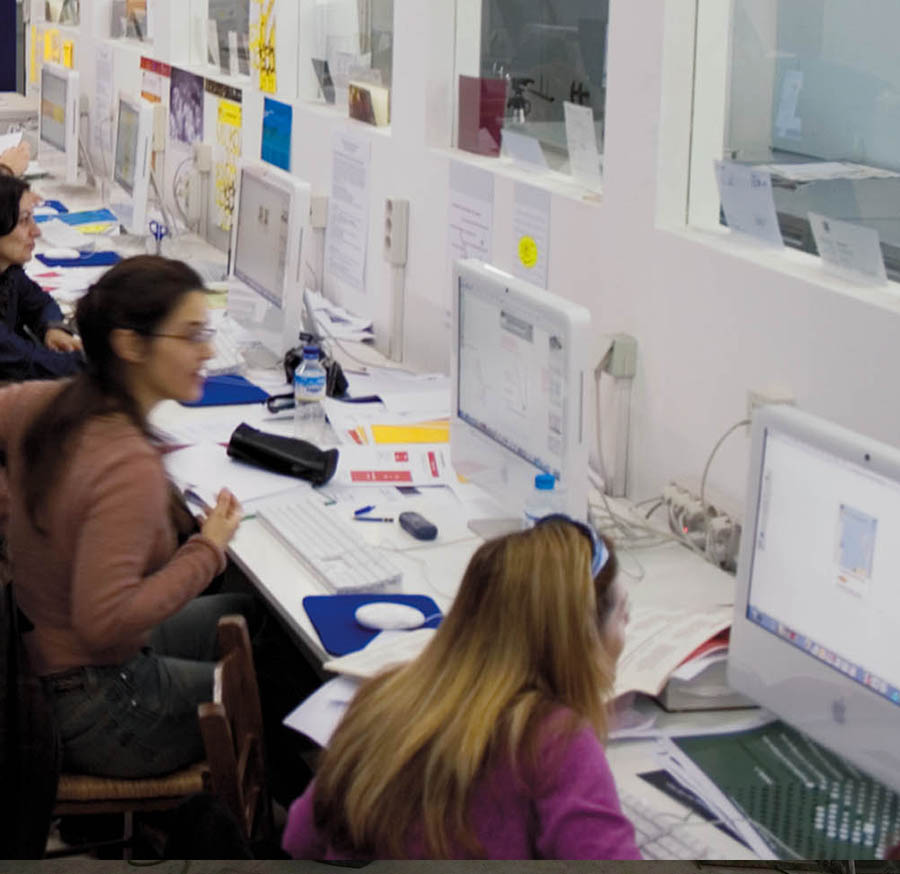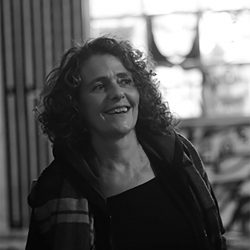GRAPHIC ARTS – TYPOGRAPHY AND THE ART OF THE BOOK

Studio for Graphic Arts, Typography and the Art of the Book
DESCRIPTION OF STUDIO COURSE
3rd SEMESTER
This course offers a comprehensive study of the history of Graphic Arts and Typography, tracing their development from the advent of writing to the contemporary digital age. The course is enriched through lectures, screenings, seminars, educational visits, and presentations by invited professionals from the field. Particular attention is also given to typography, graphic symbols, imagery, and their application across various types of print media.
The course also addresses the dynamics of spatial organization as applied in the fields of Graphic Design and Visual Communication, i.e. in the design of printed materials, books, magazines, posters, and other print-based and visual communication media, as well as of new digital media, including web design and social media content. Furthermore, it explores how all these applications serve as vehicles for the dissemination of social and political ideas, in addition to their use in advertising.
Students are encouraged to develop and refine their design skills and to apply them creatively in the development of original concepts and visual communication strategies.
The aim of this course is to:
- Introduce students to the fundamental principles, techniques, and materials of graphic design, with a particular emphasis on typography and typographic elements.
- Foster an understanding of graphic design and visual communication across all forms and media.
- Enable students to develop their ideas, skills, and creative potential.
- Cultivate negotiation, project management, personal, and collaborative skills through engagement with external projects, alternative spaces, and creative opportunities.
- Encourage the exploration of materials, media, and methodologies relevant to key thematic areas, including social design, branding, information design, typographic media, and communication environments.
4th SEMESTER
This semester emphasises the integration of image and typographic elements through both traditional design methods and specialised computer software. Instruction in digital design tools is delivered through real-time tutorials, conducted on computers available at the Studio as well as on students’ personal laptops, in a classroom with a projector. Assignments and all necessary files for their completion are provided to students after each session for further practice. The teaching of graphic design applications is structured so as to equip students not only with the knowledge required to complete course assignments, but also with competencies applicable to further professional design work. Students engage in the design of small-scale printed materials, magazine covers, and posters, with final outputs produced using either traditional or digital printing methods.
In parallel, analytical discussions are held to cultivate both creative and critical thinking, with the aim of supporting the coherent presentation of design concepts.
Additionally, students are given the opportunity to work in the School’s printing workshop, where they manually compose text and print small publications using either a platen press or an offset press.
The aim of this course is to:
- To further develop the knowledge and skills acquired in the previous semester.
- To expand the fields of activity and application of Graphic Design and Visual Communication.
- To build on negotiation, project management, as well as personal and teamwork skills through external projects, alternative settings, and creative opportunities.
- To advance students’ ideas, capabilities, and creativity.
- To develop negotiation, project management, personal, and collaborative skills through external projects, alternative settings, and creative opportunities.
- To encourage participation in both local and international competitions.
5th SEMESTER
This semester places emphasis on the methodology of book design, focusing on layout, the integration of illustration and typographic elements, utilising both traditional design techniques and relevant computer software. Projects include the development of corporate identity, small-scale printed materials, magazine covers, and posters, which are finalized through traditional or digital printing methods. The curriculum also covers the study of typographic elements and the design and implementation of digital typefaces (Typeface Design). In parallel, analytical discussions are conducted to foster both creative and critical thinking, aiming at the comprehensive presentation of design concepts.
Additionally, students are given the opportunity to work in the School’s printing workshop, where they manually compose text and print small publications using either a platen press or an offset press.
6th - 7th – 8th SEMESTER
These semesters emphasize experimental, research-based, historical, theoretical, and critical approaches related to the development of a comprehensive design proposal. Students undertake the complete study and design of a corporate identity, poster, and accompanying printed materials. The final outcome is presented in printed form, using either traditional or modern printing techniques. This course provides students with the opportunity to further refine their design skills and apply them to new ideas, with the goal of producing an innovative and competitive portfolio. Emphasis is placed on both the design and printed execution, as well as the creation and maintenance of the portfolio in digital form for online presentation.
The aim of the courses is to :
- To further develop the knowledge and skills acquired in the previous semester.
- To broaden the fields of activity and application of Graphic Design and Visual Communication.
- To build on negotiation and project management, as well as personal and teamwork skills, through external projects, alternative settings, and creative opportunities.
- To advance individual ideas, capabilities, and creativity.
- To develop negotiation and project management, as well as personal and teamwork skills, through external projects, alternative settings, and creative opportunities.
- To encourage participation in both local and international competitions.
- To develop a high-quality and competitive design portfolio.
- To expand the range of competencies in typography, web design, visual communication, marketing, motion graphics, packaging, illustration, infographics, design software, research methods, and evidence-based visual presentation of projects.
Studio programme
The Studio is open every day (Monday to Friday), with mandatory attendance on Mondays, Wednesdays, and Fridays from 17:00 to 20:00. The instructor is available for scheduled consultations every Monday from 14:00 to 17:00.
Specifically, on Mondays and Wednesdays, the programme includes lectures in Graphic Design Theory, practical studio work – project assignments and evaluation. On Fridays, there is practical studio work on digital design applications using software such as Adobe Photoshop, Adobe Illustrator, Adobe InDesign, and FontLab Studio. Instruction includes image editing, digital colour management, comic book digital coloring, vector graphics creation and editing, as well as project assignments and evaluations (e.g. poster design, illustration and cover design, book layout, typeface design and implementation, and lettering). At regular intervals, seminars and workshops are organised in collaboration with external contributors – professionals in the field or alumni of the School – on topics such as traditional calligraphy, comic book design, typeface design and technology, 2D animation, and bookbinding. In parallel, outreach and engagement with external organisations are encouraged through commissioned projects (e.g., logo design, poster creation), and workshops are also held at the School’s printing workshop (design and printing with traditional exlibris techniques or experimental art books).


